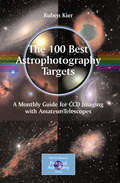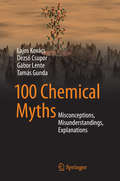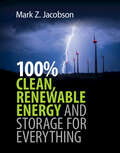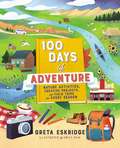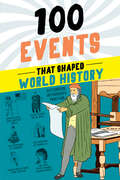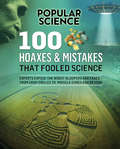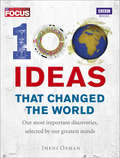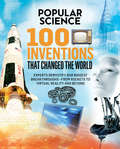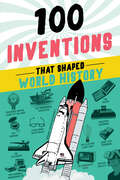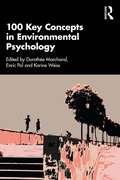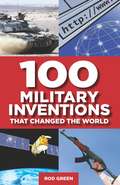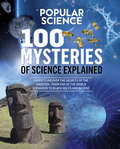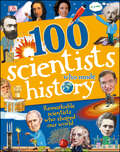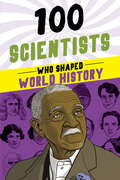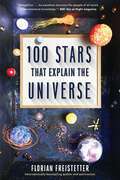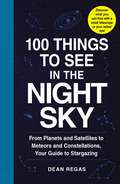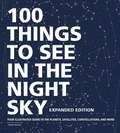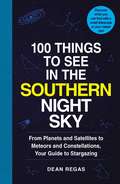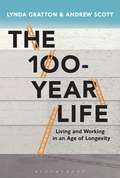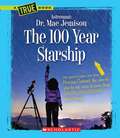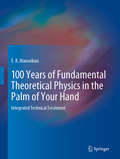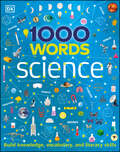- Table View
- List View
The 100 Best Astrophotography Targets
by Ruben KierAny amateur astronomer who is interested in astrophotography, particularly if just getting started, needs to know what objects are best for imaging in each month of the year. These are not necessarily the same objects that are the most spectacular or intriguing visually. The camera reveals different things and has different requirements. What objects in the sky tonight are large enough, bright enough, and high enough to be photographed? This book reveals, for each month of the year, the choicest celestial treasures within the reach of a commercial CCD camera. Helpful hints and advice on framing, exposures, and filters are included. Each deep sky object is explained in beautiful detail, so that observers will gain a richer understanding of these astronomical objects. This is not a book that dwells on the technology of CCD, Webcam, wet, or other types of astrophotography. Neither is it a book about in-depth computer processing of the images (although this topic is included). Detailed discussions of these topics can be found in other publications. This book focuses on what northern latitude objects to image at any given time of the year to get the most spectacular results.
100 Chemical Myths: Misconceptions, Misunderstandings, Explanations
by Gábor Lente Lajos Kovács Dezső Csupor Tamás Gunda100 Chemical Myths deals with popular yet largely untrue misconceptions and misunderstandings related to chemistry. It contains lucid and concise explanations cut through fallacies and urban legends that are universally relevant to a global audience. A wide range of chemical myths are explored in these areas; food, medicines, catastrophes, chemicals, and environmental problems. Connections to popular culture, literature, movies, and cultural history hold the reader's interest whilst key concepts are beautifully annotated with illustrations to facilitate the understanding of unfamiliar material. Chemical Myths Demystified is pitched to individuals without a formal chemistry background to fledgling undergraduate chemists to seasoned researchers and beyond.
100% Clean, Renewable Energy and Storage for Everything
by Mark Z JacobsonNumerous laws – including the Green New Deal – have been proposed or passed in cities, states, and countries to transition from fossil fuels to 100% clean, renewable energy in order to address climate change, air pollution, and energy insecurity. This textbook lays out the science, technology, economics, policy, and social aspects of such transitions. It discusses the renewable electricity and heat generating technologies needed; the electricity, heat, cold, and hydrogen storage technologies required; how to keep the electric power grid stable; and how to address non-energy sources of emissions. It discusses the history of the 100% Movement, which evolved from a collaboration among scientists, cultural leaders, business people, and community leaders. Finally, it discusses current progress in transitioning to 100% renewables, and the new policies needed to complete the transition. Online course supplements include lecture slides, answers to the end-of-chapter student exercises, and a list of extra resources.
100 Days of Adventure: Nature Activities, Creative Projects, and Field Trips for Every Season
by Greta EskridgeTurn off the screen and turn on the creativity as second-generation homeschooling mom Greta Eskridge shares 100 hands-on learning activities for kids that will connect and enrich your family through adventures, small and big.Have a meteor slumber party, attend a symphony concert, take a hike in the rain, preserve colorful fall leaves, and make nettle pesto as children explore a love of nature and venture into the great, wide, real world. From backyard bugs to farmer's market veggies, children will unplug from electronics; explore the world; and learn about nature, art, music, and themselves through STEAM projects and new experiences.100 Days of Adventure will spark curiosity in 6- to 10-year-olds withIndoor and outdoor seasonal activities, projects, experiments, crafts, recipes, and field tripsFree and low-cost activities, with options for different kinds of groups and locationsStep-by-step directions, nature journal prompts, tips, and checklistsBeautiful photos and helpful illustrationsChildren can bond with parents and siblings, learn new skills with individual investigations, or explore with friends in an educational or homeschool group with this full-color activity book. Also included is a note to parents with encouraging start-here guidance on growing a family culture of curiosity and adventure.Whether your family is looking for fun activities for school breaks at home, road trip vacations, or everyday ways to learn together, this collection of interactive educational activities will help your kids get creative, get into nature, and get closer to each other.Don't miss Greta's essential guide for parents on building a connected and loving family through exploration, Adventuring Together: How to Create Connections and Make Lasting Memories with Your Kids.
100 Events That Shaped World History (100 Series)
by Bill YenneDiscover the fascinating stories behind the most important events of all time in this history book for kids 8 and up!From the founding of Rome to people walking on the moon, 100 Events That Shaped World History introduces kids to the greatest discoveries, most important battles, and most pivotal movements that changed the course of human history. This history book for kids features:100 easy-to-read stories of important moments in history: Find out how the modern world came to be!Illustrated images: Each page includes an illustration to help bring history to life!A timeline, trivia questions, project ideas, and more: Boost your learning and test your knowledge with fun activities and resources!Engaging and packed with facts, this book is the perfect classroom resource or history gift for curious kids!
100 Hoaxes & Mistakes That Fooled Science (Popular Science)
by The Editors of Popular ScienceEven experts get duped from time to time! The stories behind scientific fakes and mistakes, from crop circles to miracle cures and beyond. Science is an ongoing quest for knowledge filled with discoveries and experiments, trial and error. And occasionally, the errors can be whoppers—especially when hoaxers are involved. Some hoaxes are intended merely as well-intended humorous tricks, while others are serious frauds devised for personal gain of glory and riches. This book reveals the greatest science hoaxes and mistakes of all time. Discover the truth behind 100 of the most scandalous scientific errors and outright lies in this fascinating read brought to you by Popular Science—from the experiment that suggested time travel was possible, to the pursuit of alchemy, to rumors about red mercury and its mythical powers, it&’s an entertaining journey through the history of science.
100 Ideas that Changed the World: Our Most Important Discoveries, Selected By Our Greatest Minds
by Jheni OsmanEvery once in a while, an idea comes along that makes the entire world sit up and take notice. From the earliest understandings of our place in the solar system, via Darwinism, DNA, neutrons and quarks, right up to the theories that are pushing the boundaries of our knowledge today, we are forever propelled forward by our most gifted scientific minds. In this fascinating book, former BBC Focus magazine editor Jheni Osman explores 100 of the most forward thinking, far-reaching and downright inspired ideas and inventions in history, each nominated by experts from all fields of science and engineering. With selections from established authorities such as Brian Cox, Patrick Moore, Richard Dawkins and Marcus du Sautoy, Osman covers topics as diverse as the Big Bang, vaccination, computing, radioactivity, human genomes, the wheel and many more. Each essay looks at the logic behind these great inventions, discoveries, theories and experiments, studying the circumstances that brought them into being and assessing the impact that they had on the world at large. An intriguing and thought-provoking collection, 100 Ideas that Changed the World offers us a glimpse into the minds behind history's greatest eureka moments.
100 Inventions That Changed the World (Popular Science)
by The Editors of Popular ScienceFrom safety pins to steam engines to cell phones, the stories behind innovations that have transformed everyday lives. We take thousands of inventions for granted, using them daily and enjoying their benefits. But how much do we really know about their origins and development? This absorbing new book tells the stories behind the inventions that have changed the world, with details about: Convenience items, such as safety pins, toothbrushes, and bifocals Weapons of war, including explosives, gunpowder, and shrapnel shells Industrial advances, such as the steam engine and the power loom for weaving Transportation advances, including the airplane, the diesel engine, the automobile, and the air-inflated rubber tire Electronic marvels, including color television, the microprocessor, the personal computer, the compact disc, and the cell phone Medical advances, from antiseptic surgery to the electron microscope...and much more You&’ll also learn more about many inventors and pioneers of science and technology—including Eli Whitney, James Watt, Benjamin Franklin, Henry Bessemer, Thomas Edison, J.B. Dunlop, the Wright Brothers, Werner von Braun, Jonas Salk, J. Robert Oppenheimer, and others.
100 Inventions That Shaped World History (100 Series)
by Bill YenneFascinating stories behind 100 of the most important inventions in history, for kids 8 and upThis fast-paced journey through the most vital developments and inventions of all time features:100 easy-to-read stories: Find out how each invention came to be!Illustrations: Each entry includes an illustrated image of the invention to help bring history to life!A timeline, trivia questions, project ideas and more: Boost your learning and test your knowledge with fun activities and resources!From the compass to the printing press, television to virtual reality, readers will learn about 100 of the most important inventions, advancements, and discoveries that have changed the course of human history. Organized chronologically, this fast-paced journey through the history of technology will help kids understand how their favorite modern conveniences came to be.
100 Key Concepts in Environmental Psychology
by Dorothée MarchandThis accessible book defines 100 key concepts, ideas and processes in Environmental Psychology to provide an introductory reference work that brings together research and theory in a bite-size format. With contributions from leading figures within Environmental Psychology, each concept is clearly defined and explained within the context of issues around the environment, sustainability, climate change, nature and architecture. This book considers the involvement of psychological, physiological and social processes to understand the mechanisms that explain and contribute to the evolution of behavior and attitudes that relate to our relationship with the environment. Concepts covered include biodiversity, eco-anxiety, place identity, sustainable behaviour, climate justice and environmental attitudes. By integrating ideas from different disciplinary orientations in the field of Environmental Psychology, this book allows for a better understanding of the processes related to the individual-environment relationship, as well as the applications that they allow for in various fields of intervention. This is essential reading for students and researchers in Environmental Psychology, Sustainability Studies, Architecture and Built Environment Studies and related fields.
100 Military Inventions that Changed the World: That Changed The World
by Rod GreenNothing ensures the rapid development of new technology like the involvement of the military. <P><P>From the trebuchet and the cannon to the tank and the ballistic missile, military research programmes have produced the most devastating weapons imaginable, but military masterminds are responsible for a number of surprises along the way as well. Radar, walkie-talkies and the jet engine are more obvious examples of military inventions that are now in everyday use around the world, but there are plenty of items with which all of us come into contact on a daily basis that have been developed from military technology.<P>Rod Green describes how the microwave oven in your kitchen, the sat-nav in your car or the Internet that you use every day all owe their existence to the military as he takes us on a highly entertaining voyage of discovery through the world of military inventions ancient and modern.
100 Military Inventions that Changed the World: That Changed The World
by Philip RussellNothing ensures the rapid development of new technology like the involvement of the military. From the trebuchet and the cannon to the tank and the ballistic missile, military research programmes have produced the most devastating weapons imaginable, but military masterminds are responsible for a number of surprises along the way as well.Radar, walkie-talkies and the jet engine are more obvious examples of military inventions that are now in everyday use around the world, but there are plenty of items with which all of us come into contact on a daily basis that have been developed from military technology. Rod Green describes how the microwave oven in your kitchen, the sat-nav in your car or the Internet that you use every day all owe their existence to the military as he takes us on a highly entertaining voyage of discovery through the world of military inventions ancient and modern.
100 Mysteries of Science Explained (Popular Science)
by The Editors of Popular ScienceAnswers on subjects from dark matter to disappearing bees, from the magazine that&’s been enlightening and entertaining Americans for nearly 150 years. What happened to the Neanderthals? When is the next Ice Age due? Why do we hiccup? From end-of-the-world scenarios to what goes on within our own brains and bodies, the experts at Popular Science magazine uncover the secrets of the universe and answer 100 of science&’s most mysterious questions. With sections on Physical Matter and Forces, Space, Human Body, Earth, Other Life-Forms, and Human Triumphs and Troubles, 100 Mysteries of Science Explained takes you into the fascinating world of black holes, time travel, DNA, earthquakes, and much more.
100 Scientists Who Made History (DK 100 Things That Made History)
by Andrea MillsFrom brainy biologists and clever chemists to magnificent mathematicians and phenomenal physicists. Discover 100 remarkable scientists who shaped our world.Containing a universe of knowledge, this amazing kids' educational book tells the story of the extraordinary people who revolutionized our understanding of the world. A stunning way for children to meet science's most important people.Read through information-packed mini-biographies of 100 brilliant scientists and innovators who have shaped our society and how we see the world around us. A perfect "everything you want to know in one place" about the history of science for children aged 8-12.Readers learn about discoveries that laid the groundwork for some of the most impressive innovations in history. Biologists, chemists, physicists, doctors, coders, and astronauts are all featured including Hippocrates, Da Vinci, Alan Turing, Stephen Hawking, Neil deGrasse Tyson, and more. An attractive and engaging kids book that may inspire the next Einstein or Curie! Made for those always curious children and those who need encouragement to aspire to greatness and see the marvels of science. Put children inside the minds of scientific heroes through clever speech bubbles alongside portraits with first-person fun facts about their lives. It's a cool way to personalize these incredible people and engage children while giving them a solid base in science. Did you know that Marie Curie's notebooks are still radioactive? They're too dangerous to touch and even glow! And Louis Pasteur, who furthered the development of vaccinations and more, liked to paint in his spare time? Who knew!Learn About The Minds Who Shaped The World!Dive into the world of theories and experiments, reactions, and equations, as we meet the figures who have helped us understand our universe and our place in it. Find out why Copernicus shook the world, what elements Marie Curie discovered, and how Franklin, Crick, and Watson unlocked the secrets of our DNA. It's divided into Pioneers, Biologists, Chemists, Physicists, and Innovators, whose innovations have changed the world and continue to change it now. Discover amazing facts about the world and the people behind some of humanity's most impressive advancements. Some of the amazing trailblazers you'll meet:- Alan Turing- Marie Curie- Barbara McClintock- Leonardo da Vinci- And so many more! This fabulous title is one of five children's books in the 100 In History series. Add 100 Women Who Made History, 100 People Who Made History, 100 Events That Made History, and 100 Inventions That Made History to your bookshelf and learn more about the significant people, events, and inventions that shaped the world we live in today.
100 Scientists Who Shaped World History (100 Series)
by John Hudson TinerLearn all about the fascinating lives and tremendous impact of 100 extraordinary scientists from all over the world with this fact-filled biography collection for kidsEducational and engaging, 100 Scientists Who Shaped World History features:Simple, easy-to-read text that has been freshly updatedIllustrated portraits of each figureFascinating facts about famous and lesser-known scientistsA timeline, trivia questions, project ideas and more!From Pythagorus to Isaac Newton, Louis Pasteur to Marie Curie, Rosalind Franklin to Stephen Hawking and many more, readers will be introduced to the lives and accomplishments of the greatest scientists throughout history. Organized chronologically, 100 Scientists Who Shaped World History offers a look at the amazing discoveries and advancements made by these figures and shows how scientific contributions have helped guide humanity for thousands of years.
100 Stars That Explain the Universe
by Florian FreistetterVisit one hundred extraordinary stars that unveil the mysteries of the universe Our own Sun—a source of awe, myth, and mystery for untold generations of sky-gazers—is just one of roughly two hundred billion trillion stars. Together, they’re a window into the profoundest questions in physics—overturning, again and again, how we understand light, matter, time, and existence itself. Florian Freistetter explains all this and more, in brief, easy-to-read profiles of the hundred most history-making stars, inviting readers to gaze into the past and future of the universe alongside a stellar cast of scientists— from Annie Jump Cannon, who revolutionized how we classify the stars, to Dorrit Hoffleit, who first counted them. Enjoy your journey through the cosmos . . . GRB 080319B, the farthest we’ve seen into space with the naked eye V1364 CYGNI, pivotal in the discovery of dark matter 72 Tauri, definitive evidence for Einstein’s theory of relativity Algol, called the Demon Star for its mysterious blinking—and many more! Publisher’s note: 100 Stars That Explain the Universe was previously published in hardcover as The Story of the Universe in 100 Stars.
100 Things to See in the Night Sky: From Planets and Satellites to Meteors and Constellations, Your Guide to Stargazing (100 Things to See)
by Dean RegasA handy field guide for the best stargazing experience whether in your own back yard, camping, or travelling—including information showing you which planets, constellations, stars, and manmade objects you can see with a telescope, or just your naked eye!The night sky is full of amazing things to see—from shooting stars and constellations to planets and satellites—but it can be hard to tell what you’re seeing, or where to look for the best view. 100 Things to See in the Night Sky gives you a clear picture of what you can see on any given night, either using a small telescope, or just your naked eye. Each object is presented as a separate entry, with background information on the makeup, appearance, and history of the object, along with easy-to-follow instructions on how to find it. For astronomy and space fans of all ages, this guide helps you explore the galaxy and see the stars—while keeping your feet on the ground.
100 Things to See in the Night Sky, Expanded Edition: Your Illustrated Guide to the Planets, Satellites, Constellations, and More
by Dean RegasDiscover the amazing wonders of the night sky with this expanded edition to 100 Things to See in the Night Sky, perfect for every amateur stargazer and armchair astronomer! Keep your feet on the ground and experience the night sky to the fullest by exploring planets, satellites, and constellations with this all-inclusive reference guide to space. 100 Things to See in the Night Sky, Expanded Edition is full of information on the many amazing things you can see with a telescope, or just your naked eye! From shooting stars to constellations and planets to satellites, this book gives you a clear picture of what you can see on any given night. Learn about the celestial bodies that have captured people&’s imaginations for centuries, with specific facts alongside traditional myths and beautifully illustrated photographs and star charts that will help you know where to look for the best view. With this illuminating guide, you&’ll enjoy hours of stargazing, whether you&’re travelling, camping, sitting in your back yard, or simply flipping through the beautiful images in this book.
100 Things to See in the Southern Night Sky: From Planets and Satellites to Meteors and Constellations, Your Guide to Stargazing (100 Things to See)
by Dean RegasA handy field guide for the optimum stargazing experience, whether you’re travelling, camping, or in your own backyard!The night sky is full of amazing things to see, from shooting stars and constellations, to planets and satellites, but it can be hard to tell what you’re seeing, or where to look for the best view. 100 Things to See in the Southern Night Sky lets you know what you can expect to see on any given night, whether you’re using a small telescope, or just your naked eye. 100 Things to See in the Southern Night Sky—especially for those south of the equator—includes background information on the makeup, appearance, and history of each celestial object, along with easy-to-follow instructions on the best way to catch a glimpse of these cosmic glories. With this helpful guide you’ll have the world on a string—or more precisely, the sky in your hands.
\The 100-Year Life: Living And Working In An Age Of Longevity
by Lynda Gratton Andrew ScottWhat will your 100-year life look like?Does the thought of working for 60 or 70 years fill you with dread? Or can you see the potential for a more stimulating future as a result of having so much extra time?Many of us have been raised on the traditional notion of a three-stage approach to our working lives: education, followed by work and then retirement. But this well-established pathway is already beginning to collapse - life expectancy is rising, final-salary pensions are vanishing, and increasing numbers of people are juggling multiple careers. Whether you are 18, 45 or 60, you will need to do things very differently from previous generations and learn to structure your life in completely new ways. The 100-Year Life is here to help. Drawing on the unique pairing of their experience in psychology and economics, Lynda Gratton and Andrew Scott offer a broad-ranging analysis as well as a raft of solutions, showing how to rethink your finances, your education, your career and your relationships and create a fulfilling 100-year life. #65533; How can you fashion a career and life path that defines you and your values and creates a shifting balance between work and leisure?#65533; What are the most effective ways of boosting your physical and mental health over a longer and more dynamic lifespan?#65533; How can you make the most of your intangible assets - such as family and friends - as you build a productive, longer life?#65533; In a multiple-stage life how can you learn to make the transitions that will be so crucial and experiment with new ways of living, working and learning?Shortlisted for the FT/McKinsey Business Book of the Year Award, The 100-Year Life is a wake-up call that describes what to expect and considers the choices and options that you will face. It is also fundamentally a call to action for individuals, politicians, firms and governments and offers the clearest demonstration that a 100-year life can be a wonderful and inspiring one.
The 100 Year Starship (A True Book)
by Dana Meachen Rau Mae JemisonSo far, our travels into outer space have been limited to the planets and moons surrounding the sun in our own solar system. What would we find if we made it all the way to another star's solar system? Today's astronomers are planning a mission to explore further reaches of space than humans have ever reached. Readers will discover how these bold scientists are working to build faster spaceships and overcome the obstacles that make it difficult for humans to survive in outer space.
100 Years of Fundamental Theoretical Physics in the Palm of Your Hand: Integrated Technical Treatment
by E. B. ManoukianThis book aims to integrate, in a pedagogical and technical manner, with detailed derivations, all essential principles of fundamental theoretical physics as developed over the past 100 years. It covers:Quantum physics and Stability Problems in the Quantum World, Minkowski Spacetime PhysicsParticle Classifications and Underlying Symmetries, Symmetry Violations, Quantum Field Theory of Particle Interactions, Higgs Field Physics, Supersymmetry: A Theory with Mathematical BeautySuperstrings, Gravity and Supergravity, General Relativity Predictions, including Frame Dragging, Intricacies of Black Hole Physics, Perturbative and Non-perturbative Quantum GravityIntricacies of Modern Cosmology, including Inflation and Power Spectrum If you are in the process of learning, or are lecturing on, any of the subjects above, then this is your book - irrespective of your specialty.With over-specialization and no time to master all the fields given above, students, and perhaps many physicists, may find it difficult to keep up with all the exciting developments going on, and are even less familiar with their underlying technicalities: e.g. they might have heard that the Universe is 13.8 billion years old, but have no idea on how this number is actually computed.This unique book will be of great value to graduate students, instructors and researchers interested in the intricacies and derivations of the many aspects of modern fundamental theoretical physics. And, although a graduate level book, some chapters may also be suitable for advanced undergraduates in their final year.
1000 Fragen aus Genetik, Biochemie, Zellbiologie und Mikrobiologie
by Olaf WernerDiese Studienhilfe dient Ihrer Selbstkontrolle und damit der Vorbereitung auf Prüfungen. Sie bietet Ihnen die Möglichkeit, sich mit den vielfältigen Fragen in Ruhe zu Hause auseinanderzusetzen und Ihr Wissen eigenständig zu überprüfen; oder Sie nutzen die Fragen als Anregungen, wenn Sie sich in Lerngruppen gegenseitig abfragen. Die 1000 Fragen sollen Ihnen helfen, sich in Genetik/Molekularbiologie, Biochemie, Zellbiologie und Mikrobiologie zu vertiefen, und sind nach den vier Fachgebieten geordnet. Sie finden zu den wichtigsten Themen Multiple-Choice-Fragen mit in der Regel kurzen Antworten, die Sie am Ende des Buches nachschlagen können. Die Fragen sind bewusst unterschiedlicher Natur und in unterschiedlichen Schwierigkeitsgraden. Wissensfragen erfordern ein Faktenwissen, das Sie sich in der Regel mit dem Durcharbeiten von Vorlesungen und Lehrbüchern problemlos aneignen werden. Daneben finden Sie Verständnisfragen, deren Beantwortung voraussetzt, dass Sie die Zusammenhänge in der Biologie insgesamt oder innerhalb biologischer Einzelthemen verstanden haben. Mit den 1000 Fragen sollten Sie auf ideale Weise Ihr Wissen überprüfen und Ihre Lücken erkennen können.
1000 Fragen aus Zoologie und Botanik
by Olaf WernerDiese Studienhilfe dient Ihrer Selbstkontrolle und damit der Vorbereitung auf Prüfungen. Sie bietet Ihnen die Möglichkeit, sich mit den vielfältigen Fragen in Ruhe zu Hause auseinanderzusetzen und Ihr Wissen eigenständig zu überprüfen; oder Sie nutzen die Fragen als Anregungen, wenn Sie sich in Lerngruppen gegenseitig abfragen. Zusätzlich zu den rein zoologischen und botanischen Fragen sind außerdem einige aus den verwandten Bereichen Ökologie und Evolution enthalten, um den Prüfungsstoff umfassender abzudecken. Die 1000 Fragen sollen Ihnen helfen, sich in diesen vier Themengebieten zu vertiefen und sind nach den Fachgebieten geordnet. Sie finden zu den wichtigsten Themen Multiple-Choice-Fragen mit in der Regel kurzen Antworten, die Sie am Ende des Buches nachschlagen können. Die Fragen sind bewusst unterschiedlicher Natur und in unterschiedlichen Schwierigkeitsgraden. Wissensfragen erfordern ein Faktenwissen, das Sie sich in der Regel mit dem Durcharbeiten von Vorlesungen und Lehrbüchern problemlos aneignen werden. Daneben finden Sie Verständnisfragen, deren Beantwortung voraussetzt, dass Sie die Zusammenhänge in der Biologie insgesamt oder innerhalb biologischer Einzelthemen verstanden haben. Mit den 1000 Fragen sollten Sie auf ideale Weise Ihr Wissen überprüfen und Ihre Lücken erkennen können.
1000 Words: Build Knowledge, Vocabulary, and Literacy Skills (Vocabulary Builders)
by DKIntroduce key scientific concepts to your child and encourage early reading, writing and vocabulary skillsDid you know that science is all around us, even on the playground? Open the pages of this illustrated picture and word book for young readers to discover the wonders of Science in 1000 words.This fascinating STEM education book for kids is packed with bright, detailed illustrationsand easy-to-read terms. Every picture-packed page is full of scientific concepts such as sound, light, senses, and machines, with words for each image. It&’s perfect for preschoolers or those learning English as a second language. This must-have reference book will broaden children&’s vocabulary and strengthen their early reading and writing skills. Full of fun facts and stats, leading educational experts have carefully selected each topic with questions that stimulate thinking, talking, and early science skills. This vocabulary book also includes lots of useful nouns, plus some interesting adjectives, and common verbs.Feed your child&’s curiosity and help them shape their language, science, and literacy skills. This will foster a love for science and critical thinking to inspire kids to want to know more about how the world around them works.Encourage Early Science, Vocabulary and Literacy Skills Discover a different and exciting STEM topic on every page of this science book for kids! Delve into the key scientific concepts from sound and light to plants and animals. It&’s the perfect gift for children who are curious about science and keep asking the how and why questions!Use picture-and-word association to learn about STEM topics like: • Seasons, the weather, and why things get hot and cold • Machines, materials, and junk • Being at the doctor and inside the human body • Vehicles, transport, the moon landing, and much much more
